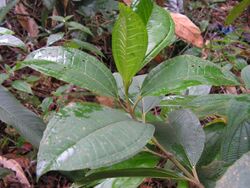Biology:Huberia (plant)
| Huberia | |
|---|---|

| |
| Huberia consimilis Baumgratz from Lagoa dos Gatos, Pernambuco, Brazil | |
| Scientific classification | |
| Kingdom: | Plantae |
| Clade: | Tracheophytes |
| Clade: | Angiosperms |
| Clade: | Eudicots |
| Clade: | Rosids |
| Order: | Myrtales |
| Family: | Melastomataceae |
| Genus: | Huberia DC. |
| Synonyms | |
| |
Huberia is a genus of flowering plants belonging to the family Melastomataceae.[1][2]
Its native range is from Ecuador to Peru, eastern and southern Brazil.[1][3][4]
General description
Most are shrubs, the leaves are opposite (arranged), petiolate (has a leaf stalk) and are serrated. It flowers with 3 flowered cymes which have a long stipitate (stalk). The flowers are similar in form to Meriania species, but tetramerous (in four parts). The receptacle (the axis of a flower) is urceolate (shaped like an urn or pitcher) or lageniform (flask-shaped) and narrowed to the neck, sometimes costate alate (ribbed like a wing). The flower has 4 sepals which are broad, and 4 petals which are longer than the calyx and much contorted. It has 8 stamens, which have a dorsal appendage which is less developed. The anthers are incurved and elongated. It has a seed capsule that is 4-valved. The seeds are sometimes imbricate (tiled and overlapping), produced on both sides to an elongated wing. The seeds are also winged and pyramidal (in form).[5]
Taxonomy
The genus name of Huberia is in honour of François Huber (1750–1831) a Swiss entomologist who specialized in honey bees, and also his son Jean Pierre Huber.[6] Augustin Pyramus de Candolle was a close friend of Huber and wrote a biographer of him in 1832.[7][8] The genus was first described and published in Prodr. Vol.3 on page 167 in 1828.[1]
Known species
According to Kew:[1]
- Huberia kollmannii Bochorny & R.Goldenb.
- Baumgratz (R.Goldenb. & R.Tav.) Bochorny & Michelang.
- Huberia laurina DC.
- Huberia limae Huberia comosa
- (Brade) Bochorny & R.Goldenb. Huberia lumiarensis
- (Bochorny, Michelang. & R.Goldenb.) Bochorny Huberia magdalenensis
- (R.Tav., Baumgratz & R.Goldenb.) Bochorny & Michelang. (Brade) Bochorny & R.Goldenb.
- Huberia mestrealvarensis (D.T.Iglesias & R.Goldenb.) Bochorny & Michelang.
- Huberia minor Huberia consimilis
- Cogn. Huberia minutifolia
- Bochorny & R.Goldenb. Huberia capixaba
- [[Baumgratz[9]]] Bochorny & R.Goldenb.[10]
- Huberia mourae (Cogn.) Bochorny & R.Goldenb.
- Huberia nettoana Huberia cordifolia
- Brade Huberia organensis
- (Saldanha & Cogn.) Bochorny & R.Goldenb. Huberia ovalifolia
- (Cogn.) Bochorny & R.Goldenb. DC.
- Huberia parvifolia Cogn.
- Huberia peruviana Huberia corymbosa
- Cogn. Huberia piranii
- Baumgratz Huberia bradeana
- (R.Goldenb. & Reginato) Bochorny & Michelang. (Cogn.) Bochorny & R.Goldenb.
- DC. Huberia sessilifolia
- R.Goldenb. & Michelang. Huberia edmundoi
- (Brade) Bochorny & R.Goldenb. Huberia staminodia
- Baumgratz (Brade) Bochorny & R.Goldenb.
- Cogn. Huberia weberbaueriana
- Baumgratz Huberia espiritosantensis
- Huberia carvalhoi Baumgratz
- Huberia glazioviana Cogn.
- Huberia glutinosa Baumgratz[9]
- (Cogn.) Bochorny & R.Goldenb. Huberia hirsuta
- Bochorny & R.Goldenb. Huberia huberioides
- Huberia cogniauxii (Brade) Bochorny & R.Goldenb.
- Huberia insignis Huberia triplinervis
- Huberia souza-limae (Cham.) Bochorny & R.Goldenb.
- Huberia semiserrata Huberia misteriosa
The type species, Huberia semiserrata DC. is listed by the United States Department of Agriculture and the Agricultural Research Service on 21 March 2005.[11]
References
- ↑ 1.0 1.1 1.2 1.3 "Huberia DC. | Plants of the World Online | Kew Science" (in en). https://powo.science.kew.org/taxon/urn:lsid:ipni.org:names:26383-1.
- ↑ John J. Wurdack 138. Melastomataceae , p. 47, at Google Books
- ↑ M.M. Grandtner and Julien Chevrette Dictionary of Trees, Volume 2: South America: Nomenclature, Taxonomy and Ecology (2013), p. 308, at Google Books
- ↑ D. J. Mabberley The Plant-Book: A Portable Dictionary of the Vascular Plants, 2nd Edt. (1997), p. 348, at Google Books
- ↑ Henri Baillon The Natural History of Plants, Volume 7 (1904), p. 21-59, at Google Books
- ↑ Burkhardt, Lotte (2018) (in German) (pdf). Verzeichnis eponymischer Pflanzennamen – Erweiterte Edition. Berlin: Botanic Garden and Botanical Museum, Freie Universität Berlin. doi:10.3372/epolist2018. ISBN 978-3-946292-26-5. https://doi.org/10.3372/epolist2018. Retrieved 1 January 2021.
- ↑ De Candolle, A.P. (October 1832). "The life and writings of Francis Huber". Edinburgh New Philosophical Journal 14: 283–296. https://books.google.com/books?id=WmQ7AQAAIAAJ&pg=PA283.
- ↑ George Don A General History of the Dichlamydeous Plants, Comprising Complete ... (1832), p. 778, at Google Books
- ↑ 9.0 9.1 Baumgratz, Jose Fernando A. (January–March 2000). "Two New Species of Huberia (Melastomataceae: Merianieae) from Brazil". Brittonia 52 (1): 24–33. doi:10.2307/2666491. Bibcode: 2000Britt..52...24B.
- ↑ Bochorny, Thuane; Goldenberg, Renato (2019). "A new species of Huberia (Melastomataceae) from Espírito Santo, Brazil". Brittonia 71 (4): 408–413. doi:10.1007/s12228-019-09568-x. Bibcode: 2019Britt..71..408B.
- ↑ "Huberia semiserrata DC. GRIN-Global". https://npgsweb.ars-grin.gov/gringlobal/taxon/taxonomydetail?id=19408.
Other sources
- Applequist, W. L. 2014. Report of the Nomenclature Committee for Vascular Plants: 66. Taxon 63:1370. Note: should be treated as earlier homonym of Hubera Chaowasku
- Baumgratz, J. F. A. 2004. Sinopse de Huberia DC. (Melastomataceae:Merianieae). Revista Brasil. Bot. 27(3):545–561.
- Chaowasku, T. 2013. (7) Request for a binding decision on whether Huberia DC. (Melastomataceae) and Hubera Chaowasku (Annonaceae) are sufficiently alike to be confused. Taxon 62:412.
Wikidata ☰ Q17156478 entry
 |

